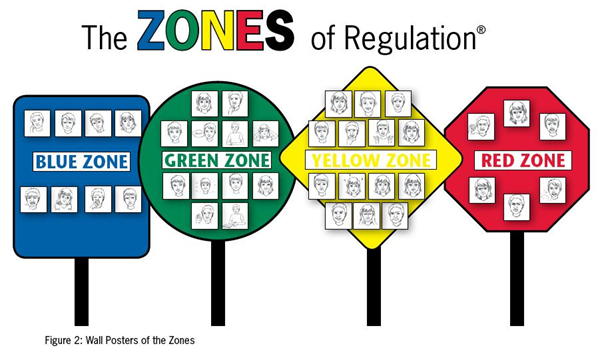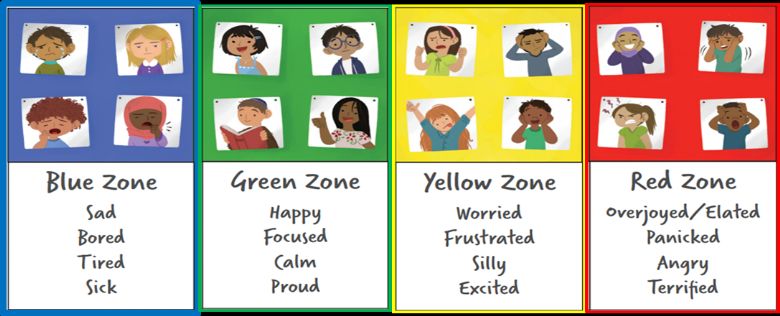Zones of Regulation

Zones of Regulation is a curriculum that has lessons and activities designed by therapist, Leah Kuypers, to help pupils gain skills in the area of self-regulation. The lessons and learning activities are designed to help pupils recognise their emotions, understand when and why they are in different zones as well as learn how to use strategies to change or stay in the zone they are in.
Self-regulation can go by many names, such as self-control, self-management and impulse control. Regulation is defined as the best state of alertness for both the body and the emotions for the specific situation children are in. For example, when you play in a team game, it is beneficial to have a higher state of alertness. However, that same state would not be appropriate in the library. The Zones of Regulation is based around the use of four colours to help children identify how they are feeling and categorise it based on colour.
The children will learn different strategies to cope and manage their emotions based on which colour zone they’re in. Through the Zones of Regulation curriculum we will teach children to identify emotions in themselves and others and provide them with a bank of strategies to help them regulate their emotions and improve their wellbeing. In addition to addressing self-regulation, the pupils will gain an increased vocabulary of emotional terms, skills in reading other people’s facial expressions, perspective about how others see and react to their behaviour, insight into events that trigger their behaviour, calming and alerting strategies, and problem solving skills.
The Zones of Regulation will help children to recognise their own triggers, learn to read facial expressions, develop problem-solving skills, and become more attuned to how their actions affect other people. There is progression across the curriculum with children in Early Years learning to identify different emotions to children in Upper Key Stage 2 discussing how our behaviour can impact upon the feelings of those around us.
A critical aspect of this curriculum is that everyone knows and understands The Zones language. This creates a comfortable and supportive environment for the child to practice his or her self-regulation skills. It also helps the children learn the skills more quickly and be more likely to apply them in many situations.
You can support your child during this process by doing the following:
- Use the language and talk about the concepts of the zones as they apply to you in a variety of environments. Make comments aloud, so the student understands it is natural that we all experience the different zones and use strategies to control (or regulate) ourselves. For example; “This is really frustrating me and making me go into the yellow zone. I need to use a tool to calm down. I will take some deep breaths.”
- Help your child gain awareness of his or her zones and feelings by pointing out your observations.
- Validate what zone your child is in and help them brainstorm expected ways to self-regulate, so their behaviour is expected for the context.
- Share with your child how his or her behaviour is affecting the zone you are in and how you feel.
- Help your child become comfortable using the language to communicate his or her feelings and needs by encouraging your child to share his or her zone with you.
- Show interest in learning about your child’s triggers and zones tools. Ask your child if he or she wants reminders to use these tools and how you should present these reminders.
- Make sure to positively reinforce your child for recognising their zone and managing their behaviours while in it, rather than only pointing out when your child are demonstrating unexpected behaviours while in a zone.
- It is important to note that everyone experiences all the zones - the red and yellow zones are not the “bad” or “naughty” zones. All the zones are expected at one time or another.
- The Zones of Regulation is intended to be neutral and not communicate judgement.

